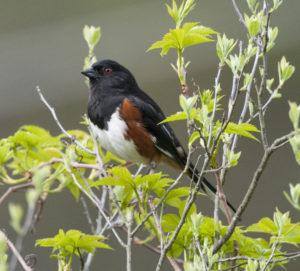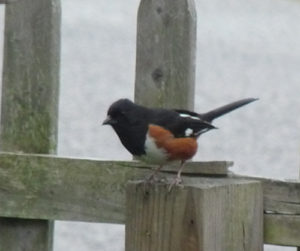Content for this page researched and created by Dr. Hamilton

The eastern towhee (Pipilo erythrophthalmus) is a large ground sparrow of the United States and Canada (Avian Web). It is on average 7 ¼ inches long with a 10 inch wingspan, a cone shaped bill, rusty-red sides and a white belly. Males have black backs, wings and heads while females have brown backs, wings and heads. Juveniles have brown and buff streaked feathers (USGS). Eastern towhees are found across eastern

North America (from southern Saskatchewan and Quebec south to Florida, and west to eastern Texas). They can live from near sea level to altitudes as high as 6,500 ft (1,980 m).
Eastern towhees live in grasslands, marshes, thickets, overgrown fields and backyards or in the edges of brushy woodland. They almost always inhabit dense shrub covers with plenty of leaf litter (Avian Web). Studies on specific habitats selected by eastern towhees have shown that the absence of exotic, invasive plant species and the presence of an open forest canopy (Breachy and Robinson) (even when that canopy is opened by gypsy moth activity (Bell and Whitman)) are favorably correlated to their presence. These favorable eastern towhee habitats also include an abundance of early forest succession habitats (Fink, et al.,Yahner, Krementz and Powell) and burn-managed grasslands (Zukerberg and Vickery).
Northern birds are larger than southern ones, and most eastern towhees have red eyes except those from Florida (which have pale (white) eyes). Eye colors that are intermediate between red and white can be seen in across some southern areas of their range (ENature).
The eastern towhee is one of the six species of towhees found in North America (Birds of North America). The eastern towhee is very similar to the western spotted towhee (Pipilo maculatus), and these two species were until very recently considered to be the same species (called the “rufous-sided towhee”). These species have overlapping ranges across the Great Plains where they can successfully interbreed (a reflection of their close similarity!). These two towhee species reflect a common evolutionary pattern in North American birds caused by the great Pleistocene ice sheets that extended down through the center of the continent. These glacial barriers separated many bird species into eastern and western populations, and, overtime, these separated populations evolved into new species (Cornell Laboratory).

There are four currently recognized subspecies of the eastern towhee. These are only weakly to moderately different from each other. Their overall size and the extent of white in its wings and tail decreases from the northern part of the range to the southern edges along the Gulf Coast, while bill, leg, and foot sizes increases in southern birds. The primary nominate subspecies is the one that breeds in the north (P. erythrophthalmus erythrophthalmus). This subspecies has red eyes and very extensive white in its tail feathers. The smaller alleni subspecies of Florida is paler and duller in color and has, as previously mentioned, straw-colored (to white-colored) eyes. Intermediate southern subspecies canaster (in the west) and rileyi (in the east) have variably orange to straw-colored eyes (National Geographic Animals). The eastern towhee breeds from southern Saskatchewan east to Maine and south to Louisiana and Florida (What Bird).
The eastern towhee spends winters across much of eastern U.S. north to Nebraska and southern New England (What Bird). . Only the northern-most birds (the nominate sub-species, P. erythrophthalmus erythrophthalmus) migrate (National Geographic). Its relative short wings, however, limits its ability to fly great distances or to great heights (Bent).

Eastern towhees spend most of their time on the ground or in low shrubs foraging for seeds, insects and fruit (National Wildlife Federation). They scratch at leaves with both feet at the same time often doing noisy, “backwards hops” while searching leaves for food (Cornell Laboratory). They are often noticed in their very dense habitats because of their loud ruffling and scratching through leaf litter (Audubon). They eat seeds (including acorns and seeds of ragweeds, smartweeds and grasses), fruits (blackberries, blueberries and strawberries), insects, spiders, millipedes, centipedes, and snails, as well as soft leaf and flower buds in spring (Cornell Laboratory). The towhee has only very rarely been observed to feed on any agricultural crops (Bent). Towhees propagate the seeds of many useful plants including blueberries, bayberries, strawberries, mulberries, and holly berries and consume large quantities of moths, caterpillars, ants, scale insects, wood borers, beetles, snails, sow bugs and other destructive pests (Wild Birds Unlimited). Eastern towhees have also been observed preying on the eggs and nestlings of other sparrow species (Maier and De Graaf).
Eastern towhees tend to be solitary and use a number of threat displays to chase off other towhees. Males lift, spread, and/or droop one or both wings, or fan and flick their tails to display the large white tail corners. Studies have shown that male towhees defend territories many times larger than needed simply to provide food (Cornell Laboratory). Male towhees have a variable array of vocalizations (whistles and clicks) but are best known for their distinctive “cherrit!” call which is frequently given from the tops of shrubs or small trees (Bent).

For northern, migrating eastern towhees small flocks of males (eight or so individuals) arrive in their breeding habitat in early spring. The males then separate and begin their territorial displays. The females arrive a few days later and mating pairs begin to sort themselves out (Bent). Birds tend to return to the same breeding sites each year (Avian Web). Mated pairs stay together for a single season (which may include up to three clutches of eggs) (Bent). The eastern towhee’s nest is a 4-inch wide outer cup made of tree and grapevine bark strips, twigs, dead leaves, leaf stems, and sometimes even string or cardboard. The space of the inner cup is about 2 inches wide and 1.5 inches deep. It is lined with fine, dry grasses, rootlets, and sometimes animal hair. The nest is on the ground and is often well buried in surrounding leaf litter under the dense cover of shrubs and other plants (Cornell Laboratory). The female does all the nest building, although the male may carry in materials for her to use. It usually takes 5 days to finish the nest (Avian Web).

There are 4 to 6 eggs in each clutch. A second clutch is laid 8 to 16 days after first clutch fledges. If eggs are destroyed by a predator relaying can occur quickly. Eggs are ovate and glossy, grayish or creamy white and occasionally greenish white with brown spots (Bent). The eggs are incubated for 12–13 days, and nestlings are reared in the nest for another 10–12 days (Cornell Laboratory). Incubation is mostly or entirely by the female, but both parents feed the nestlings (Audubon).
Cowbirds lay eggs in more than half of all towhee nests. Towhees, unlike some other birds, show no ability to recognize or remove the cowbird’s eggs (Cornell Laboratory). This high level of nest parasitism combined with an on-going decline in the shrubby, leaf litter rich habitats required by this species (declines due to both human development and also to ongoing forest succession) are the main reasons for the observed 49% decline in eastern towhees over the past 50 years (Cornell Laboratory, National Geographic Animals). Nest successes as low as 14% have been observed in cowbird affected eastern towhee populations (Twedt, et al.).

Eastern towhees may be taken as prey by hawks (Bent) and their nests are logically quite vulnerable to ground predation by raccoons, chipmunks, house cats, and a variety of snakes. Towhees are also reservoirs for a variety of ecto- and endo-parasites (Bent), but are not intermediate hosts for the bacterium that causes Lyme disease (Borrelia burgdoriferi)(Ginsberg et al.).
General References:
Bent, A. C. Life Histories of Familiar North American Birds. Eastern Towhee. Smithsonian
Institution National Museum Bulletin.1968. Web. 17 July 2016.
Eastern Towhee. All About Birds: Cornell Laboratory of Ornithology. 2015. Web. 17 July 2016.
Eastern Towhee. Avian Web Beauty of Birds. 2011. Web. 17 July 2016
Eastern Towhee. National Geographic Animals. 2016. Web. 17 July 2016
Eastern Towhee. National Wildlife Federation: Wildlife: Birds. 2016. Web. 17 July 2016.
Eastern Towhee. What Bird: Field Guide to Birds of North America. 2013. Web. 17 July 2016.
Eastern Towhee. Wild Birds Unlimited Chipper Woods Bird Observatory. 2009. Web. 17 July
2016
Eastern towhee Pipilo erythrophthalmus. Patuxent Bird Identification InfoCenter. USGS. 2000.
Web. 17 July 2016.
Eastern Towhee Pipilo erythrophthalmus. ENature. 2007. Web. 17 July 2016.
Kaufman, K. Eastern Towhee. Audubon Society Guide to North American Birds. N.d. Web. 17
July 2016.
Towhees. Birds of North America. 2016. Web. 22 July 2016
Scientific References:
Beachy, Brian L., and George R. Robinson. “Divergence in avian communities following woody
plant invasions in a pine barrens ecosystem.” Natural Areas Journal 28.4 (2008): 395-403.
Bell, Jennifer L., and Robert C. Whitmore. “Eastern towhee numbers increase following
defoliation by gypsy moths.” The Auk (1997): 708-716.
Fink, Alix D., FRANK R. THOMPSON III, and April A. Tudor. “Songbird use of regenerating
forest, glade, and edge habitat types.” Journal of Wildlife Management 70.1 (2006): 180-188.
Ginsberg, Howard S., et al. “Reservoir competence of native North American birds for the Lyme
disease spirochete, Borrelia burgdorferi.” Journal of Medical Entomology 42.3 (2005): 445
-449.
Hagan III, John M. “Decline of the Rufous-sided Towhee in the eastern United States.” The Auk
(1993): 863-874.
Krementz, David G., and Larkin A. Powell. “Breeding season demography and movements of
Eastern Towhees at the Savannah River site, South Carolina.” The Wilson Bulletin 112.2
(2000): 243-248.
Maier, Thomas J., and Richard M. DeGraaf. “Rhodamine-injected eggs to photographically
identify small nest-predators.” Journal of Field Ornithology 71.4 (2000): 694-701.
Suarez-Rubio, Marcela, Peter Leimgruber, and Swen C. Renner. “Influence of exurban
development on bird species richness and diversity.” Journal of Ornithology 152.2 (2011):
461-471.
Twedt, Daniel J., et al. “Nest survival of forest birds in the Mississippi Alluvial Valley.” The
Journal of wildlife management (2001): 450-460.
Yahner, Richard H. “Responses of bird communities to early successional habitat in a managed
landscape.” The Wilson Bulletin 115.3 (2003): 292-298.
Zuckerberg, Benjamin, and Peter D. Vickery. “Effects of mowing and burning on shrubland and
grassland birds on Nantucket Island, Massachusetts.” The Wilson Journal of Ornithology
118.3 (2006): 353-363.
Image Gallery
Sillman, D. Personal photographs.(used with permission)
- Male towhee on fence
- Male towhee in shrub (front)
- Male towhee in shrub (side)
Flickr. Yahoo . 2012. Web. 23 July, 2016. <http://www.flickr.com/photos>
(Use via Creative Commons)
- Towhee nest (J. Mayer) (creative commons)
Wikimedia Commons. Wikimedia Project . Web. 23July, 2016
<.http://commons.wikimedia.org/wiki/>
(Use via Creative Commons)
- Adult male towhee (K. Thomas) (USFWS) (Public domain)
- Female towhee (K. Thomas) (Public domain)
- Adult male in a bush (B. Thompson) (USFWS)(Public domain)